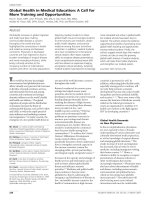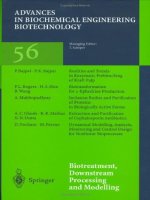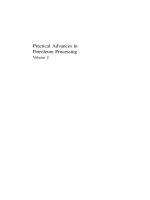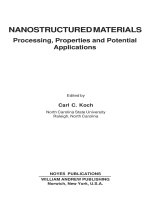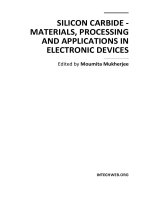ADVANCES IN CERAMICS CHARACTERIZATION, RAW MATERIALS, PROCESSING, PROPERTIES, DEGRADATION AND HEALING pptx
Bạn đang xem bản rút gọn của tài liệu. Xem và tải ngay bản đầy đủ của tài liệu tại đây (47.71 MB, 382 trang )
ADVANCES IN CERAMICS -
CHARACTERIZATION,
RAW MATERIALS,
PROCESSING, PROPERTIES,
DEGRADATION AND
HEALING
Edited by
Costas Sikalidis
Advances in Ceramics - Characterization, Raw Materials,
Processing, Properties, Degradation and Healing
Edited by Costas Sikalidis
Published by InTech
Janeza Trdine 9, 51000 Rijeka, Croatia
Copyright © 2011 InTech
All chapters are Open Access articles distributed under the Creative Commons
Non Commercial Share Alike Attribution 3.0 license, which permits to copy,
distribute, transmit, and adapt the work in any medium, so long as the original
work is properly cited. After this work has been published by InTech, authors
have the right to republish it, in whole or part, in any publication of which they
are the author, and to make other personal use of the work. Any republication,
referencing or personal use of the work must explicitly identify the original source.
Statements and opinions expressed in the chapters are these of the individual contributors
and not necessarily those of the editors or publisher. No responsibility is accepted
for the accuracy of information contained in the published articles. The publisher
assumes no responsibility for any damage or injury to persons or property arising out
of the use of any materials, instructions, methods or ideas contained in the book.
Publishing Process Manager Nikša Mandić
Technical Editor Teodora Smiljanic
Cover Designer Jan Hyrat
Image Copyright Vladoleg, 2010. Used under license from Shutterstock.com
First published July, 2011
Printed in Croatia
A free online edition of this book is available at www.intechopen.com
Additional hard copies can be obtained from
Advances in Ceramics - Characterization, Raw Materials, Processing, Properties,
Degradation and Healing, Edited by Costas Sikalidis
p. cm.
ISBN 978-953-307-504-4
Contents
Preface IX
Part 1 Topics in Characterization Techniques
and Evaluation of Advanced Ceramic Materials 1
Chapter 1 On the Use of Photothermal Techniques
as a Tool to Characterize Ceramic-Metal Materials 3
F. A. L. Machado, M. Filgueira,
R. T. Faria Jr. and H. Vargas
Chapter 2 Spectroscopic and Dielectric Characterization
of Plasma Sprayed Titanates 19
Pavel Ctibor and Josef Sedlacek
Chapter 3 Thermal Diffusivity of Ceramics
During Neutron Irradiation 39
Masafumi Akiyoshi, Hidetsugu Tsuchida and Toyohiko Yano
Chapter 4 Luminescence Properties of AlN Ceramics
and Its Potential Application for Solid State Dosimetry 59
Laima Trinkler and Baiba Berzina
Chapter 5 Non-Contact Measurements of the Apparent Density of
Green Ceramics with Complex Shape 83
G.M. Revel, E.P. Tomasini, G. Pandarese and A. Cavuto
Chapter 6 Practical Methods for Crack Length Measurement and
Fatigue Crack Initiation Detection Using
Ion-Sputtered Film and Crack Growth Characteristics
in Glass and Ceramics 103
Gang Deng and Tsutomu Nakanishi
Chapter 7 Evolution of Crystallographic Structures and Phases
in Micropyretically Formed Boron Rich Boron Carbide –
a New Material System 127
R.M. Mohanty, K. Balasubramanian and S.K. Seshadri
VI Contents
Chapter 8 Oxygen Isotope Exchange in Nanocrystal Oxides 139
Anatoly Fishman, Tatyana Kurennykh,
Vladimir Vykhodets and Evgeniya Vykhodets
Chapter 9 Lead Free BNBT Type Ceramics:
A Useful Material for Sensors
and Ultrasound Applications 165
E. Suaste Gómez and J. J. A. Flores Cuautle
Part 2 Topics in Characterization and Mechanical Properties
of Conventional and Advanced Ceramic Materials 181
Chapter 10 Characterization of the Firing Steps
and Phases Formed in Mg-Zr-Containing
Refractory Dolomitic Materials 183
Araceli Lavat, María Cristina Grasselli
and Eugenia Giuliodori Lovecchio
Chapter 11 Characterization of Clay Ceramics
Based on the Recycling of Industrial Residues
– On the Use of Photothermal Techniques
to Determine Ceramic Thermal Properties
and Gas Emissions during the Clay Firing Process 205
Faria Jr. R. T., Souza V. P., Vieira C. M. F., Toledo R.,
Monteiro S. N., Holanda J. N. F. and Vargas H.
Chapter 12 Mechanical Properties
of Kaolin-Base Ceramics During Firing 229
Igor Štubňa, Anton Trník,
František Chmelík and Libor Vozár
Chapter 13 Mechanical Properties of New Ceramic Materials
Obtained from Granular Solid Residuals
Coming from Mines and Diatomaceous Earth 245
Jaime Vite-Torres, María del Carmen Carreño de León,
Manuel Vite-Torres and Juan Rodrigo Laguna-Camacho
Chapter 14 Strength of a New All-Ceramic Restorative Material
“Turkom-Cera” Compared to Two Other Alumina-Based
All-Ceramic Systems 259
Bandar M. A. AL-Makramani, Abdul A. A. Razak
and Mohamed I. Abu-Hassan
Chapter 15 Physical and Metallurgical Characteristics
of Fiber Reinforced Ceramic Matrix Composites 281
Zdeněk Jonšta, Evelyn A. Bolaňos C.,
Monika Hrabalová and Petr Jonšta
Contents VII
Part 3 Topics in Degradation, Aging and Healing
of Ceramic Materials 299
Chapter 16 Considerations about Degradation of the Red Ceramic
Material Manufactured with Granite Waste 301
Xavier Gustavo de Castro, Saboya Fernando,
Maia Paulo Cesar de Almeida and Alexandre Jonas
Chapter 17 Behavior of Aging, Micro-Void, and Self-Healing
of Glass/Ceramic Materials and Its Effect
on Mechanical Properties 327
Wenning Liu, Xin Sun and Moe Khaleel
Chapter 18 Crack-Healing Ability of Structural Ceramics and
Methodology to Guarantee the Reliability
of Ceramic Components 351
Koji Takahashi, Kotoji Ando and Wataru Nakao
Preface
Materials’ Characterization refers to the use of external techniques aiming to better
understand the structure, composition and properties of materials. In order to
characterize a material what is usually needed is to determine its chemical, structural
(mineralogical) and technological characteristics (determine the properties connected
to the use). Characterization can take the form of actual materials testing, or analysis.
Many techniques are applied today among which are: scanning and transmission elec-
tron microscopy (SEM, TEM, STEM); focused ion beam (FIB); secondary ion mass
spectrometry (SIMS), and Rutherford backscattering (RBS), X-ray diffraction, reflectiv-
ity and fluorescence (XRD, XRR, XRF) including high-temperature analysis; Auger
electron spectroscopy (AES), and X-ray photoelectron spectroscopy (XPS), atomic force
microscopy, (AFM), Optical spectroscopy (Raman, Photoluminescence, FTIR, ellip-
sometry, etc.), thermal analysis (TG-DTA, DSC, etc); In addition, a great number of
technological tests has been standardised to determine properties relevant to the ap-
plication of each material. Furthermore, specific techniques have been developed to
determine special characteristics pertinent to each material.
Some of today’s most interesting research topics in materials’ characterization and
evaluation, included in this volume, are: the use of the non-destructive laser-induced
photothermal techniques that are based on the detection of periodic thermal waves
generated due to a non-radiative de-excitation, to characterize ceramic-metal
materials; the use of Raman and infrared spectroscopy and near-field microwave
microscopy and dielectric measurements to characterize and evaluate plasma sprayed
titanates; the measurement of positron annihilation lifetime on heavily neutron irradi-
ated ceramics to clarify changes due to neutron irradiation in thermal diffusivity one
of the most important factors for a nuclear plant efficiency; the use of
photoluminescence, thermoluminescence and optically stimulated luminescence
methods to study of Aluminum nitride and its potential application for solid state do-
simetry; the use of a newly developed non-contact method based on ultrasonic wave
propagation within the material in order to measure and control the green density
(which affect the shrinkage, the sintering and the mechanical properties of green and
fired ceramic product) of ceramics with complex shape; the use of a newly developed
method based on the application of an ion-sputtered film on a surface in order to
detect fatigue crack initiation and evaluate crack growth characteristics in ceramics
X Preface
and glasses; the investigation of the existence of a polytypic multi-structured boron
carbide with varying B/C ratio, chemically formed through a single step solid step
process using XRD, XRF and SEM techniques in order to establish the products; the
investigation of oxygen isotope exchange between oxygen-containing gases
18
О2 and
С
18
О2 and oxides examining the isotope exchange not in bulk samples but in
nanoscale oxides by employing secondary ion mass spectrometry and nuclear
microanalysis; the evaluation of the perovskite structure lead free BNBT type ceramics
for sensors and ultrasonic applications by applying SEM and XRD techniques as well
as dielectric, pyroelectric, thermal and ultrasonic measuring techniques.
The evaluation and use of local raw materials through development of new composi-
tions for ceramics with conventional applications is of vast importance since it en-
forces local economies and reduces local unemployment. Raw materials and ceramic
production processes, through the modification of the microstructure characteristics,
directly affect all the properties of ceramics and hence the mechanical properties as
compressive, tensile and shear strength, fracture toughness and ductility, hardness
and abrasion resistance and elasticity/plasticity. Mechanical properties are important
in structural and building ceramics, and are under consideration in development in
almost all the categories of ceramic products.
Some of today’s highly interesting research topics in raw materials, processes and
mechanical and other properties of conventional and advanced ceramic materials,
included in this volume, are: The evaluation of local raw materials for the production
of MgO-CaZrO
3 refractories for the cement industry by investigating the firing steps
and the phases formed during firing by employing XRF, particle size analysis, BET,
FTIR, XRD, SEM and EDAX techniques; the utilization of wastes and residues from steel
and sanitary ware industry, as raw materials for clay based ceramics and the determination
of chemical and mineralogical characteristics as well as their thermal properties using
phothermal techniques and the gas emissions during firing; the study of modulus of rupture
and Young’s modulus of kaolin based ceramics in connection to their firing schedule;
the mechanical properties of new ceramic materials obtained from granular solid re-
siduals coming from mines and diatomaceous earth; the comparative study of the
effect of special dental ceramic materials and margin design on the occlusal fracture
resistance; the mechanical and other properties of advanced fiber reinforces ceramic
matrix composites and the affection of the preparation techniques.
Materials in general, can be categorized as Metals, Organics (Plastics), Ceramics and
Composites. Materials might be degraded by chemicals, heat, moisture, radiation,
enzymatic action, mechanical wear, fatigue, creep, age etc. The environmental action,
which is a combination of several of the aforementioned parameters, degrades,
however to a different extent, all types of materials. Ceramics are generally considered
more stable materials than others. The changes on the properties of materials with
time due to interaction with air, moisture, environmental hazards etc., are often
lumped together under the label "aging". The mechanisms of degradation and aging,
Preface XI
the effects of material’s characteristics as well as the nature of the environment-
material interface, the effects of degradation and aging on the material, all need to be
investigated in order for degradation preventing techniques and protective ones to be
developed.
A few of today’s very interesting research topics on degradation, aging and healing
usage of ceramic materials, included in this volume, are: the effect on artificial and
natural degradation of ceramic bricks when granite waste is incorporated in the raw
materials; the behavior of aging, micro-void, and self-healing of glass/ceramic materi-
als and its effect on mechanical properties; the crack-healing ability of structural ce-
ramics and methodology to guarantee the reliability of ceramic components.
The current book consists of eighteen chapters divided into three sections.
Section I includes nine topics in characterization techniques and evaluation of
advanced ceramics dealing with newly developed photothermal, ultrasonic and ion
spattering techniques, the neutron irradiation and the properties of ceramics, the
existence of a polytypic multi-structured boron carbide, the oxygen isotope exchange
between gases and nanoscale oxides and the evaluation of perovskite structures
ceramics for sensors and ultrasonic applications.
Section II includes six topics in raw materials, processes and mechanical and other
properties of conventional and advanced ceramic materials, dealing with the
evaluation of local raw materials and various types and forms of wastes for ceramics
production, the effect of production parameters on ceramic properties, the evaluation
of dental ceramics through application parameters and the reinforcement of ceramics
by fibers.
Section III, includes three topics in degradation, aging and healing of ceramic
materials, dealing with the effect of granite waste addition on artificial and natural
degradation bricks, the effect of aging, micro-voids, and self-healing on mechanical
properties of glass ceramics and the crack-healing ability of structural ceramics.
2011
Constantinos A. Sikalidis
Department of Chemical Engineering
Aristotle University of Thessaloniki,
Greece
Part 1
Topics in Characterization Techniques and
Evaluation of Advanced Ceramic Materials
1
On the Use of Photothermal Techniques as a
Tool to Characterize Ceramic-Metal Materials
F. A. L. Machado, M. Filgueira, R. T. Faria Jr. and H. Vargas
Universidade Estadual do Norte Fluminense Darcy Ribeiro, Campos dos Goytacazes-RJ
Brazil
1. Introduction
Since the discovery of the photoacoustic effect by Bell in 1881 (Bell, 1880), the so-called
photoacoustic techniques have experienced great expansion. Since 1980, approximately,
they have been used in a wide range of scientific areas. The photoacoustic and related
photothermal techniques have proved to be a valuable tool to thermal characterization of
solids, liquids and gases (Vargas & Miranda, 2003). This is one of the non-destructive laser-
induced photothermal techniques that are based on the detection of periodic thermal waves
generated due to a non-radiative de-excitation in the sample, which is illuminated by a
chopped or pulsed optical excitation. In this chapter, thermal and structural characteristics
of hardmetal (WC-10%wt Co) alloys were examined.
Hardmetal is a composite material (ceramic-metal) comprised by hard tungsten carbide –
WC grains or particles, embedded into a tough binder – normally cobalt - Co (Allibert,
2001). Co percolates the WC particles, forming the WC-Co structure – the most common
hardmetal alloy.
The hardmetal’s formation occurs through the liquid phase sintering of the as compacted
WC and Co powders, at temperatures roughly about 1400ºC, in which Co spreads around
WC grains and particles, enabling homogeneity, density, hardness and other desired
properties.
Both phases can be modified, aiming at achieving the final desired properties (Upadhyaya,
2001). As an example, the binder phase amount is linked to the hardmetal properties, that is,
as large is the Co amount, as lower is the hardness, but the fracture toughness is
substantially improved.
Hardmetals present high hardness, good wear resistance, and considerable fracture
toughness, allied with interesting thermal properties. These materials have been widely
used in industry, due to the excellent combination among wear, impact, compressive
resistance, high elastic modulus, corrosion and thermal shock resistance (Allibert, 2001;
Fang et al., 2009). Therefore, due to the high stability and excellent mechanical properties,
their main applications includes the cutting tools in general, oil and gas well drills, forming
parts – such as wire drawings tools, high energy milling components, among others (Gille et
al ., 2002).
Thermal characterization plays an important role to qualify hardmetals, rare are the
literatures with the purpose of analyzing these properties (Faria Jr. et al., 2005, Kny &
Neumann, 1985). This study intends to discuss the thermal behavior in six diversified WC-
Advances in Ceramics - Characterization,
Raw Materials, Processing, Properties, Degradation and Healing
4
10%wtCo samples (table 1), which are sintered in a not-conventional route metallurgic
powder named high pressure-high temperature (HPHT), normally used to produce
synthetic diamonds. For more details of HPHT see references (Faria Jr. et al., 2005, Osipov,
et al., 2003).
2. Experimental
2.1 Samples
Figure 1 shows the route employed to process the hardmetal WC-10%wtCo. Commercial
powders of WC and Co, mean both particle size of 5μm, were purchased from Derivata
Ind.Com. These powder were manually mixed to perform the desired stoichiometry. The
theoretical density of this hardmetal is 14.7g/cm
3
. Mixture was divided in samples of 1g
each, approximately. Samples were put into a graphite cylinder that acts as a heater (current
flow during pressing) and then assembled into a calcite capsule – responsible for the gasket
formation, that ensures a good high pressure distribution into the material. Sintering
treatments were carried out using a special hot press (by Ryazantyashpressmash - O138B
type – 2500tons) – industrial scale, commonly used for diamonds’ synthesis.
Powder mix of WC + 10%wt Co
↓
Assembling the powder mixtures into a graphite cylinder, inside a calcite capsule
↓
High pressure – High Temperature Sintering
↓
Characterization: structure, microstructure and thermal properties
Fig. 1. Experimental flowchart for the HPHT hardmetal sintering (Rodrigues et. al, 2005)
2.2 Hardmetal processing
Hardmetals’ processing is carried out by the conventional powder metallurgy – PM
techniques, where the starting powders are blended, compacted in a determined part
dimensions and geometry, and then sintered, whose objective is to acquire a product with
controlled chemical composition, near net shape and mechanical properties (Borges et al.,
2008). Therefore, sintering is the most important processing step.
2.2.1 Sintering
In this step, the compacted powders are submitted to high temperature, into a furnace.
During sintering several hardmetal structural changes occurs, such as densification and
grain growth.
Sintering parameters like time, temperature and environment are designed for controlling
the porosity level, grain size, hardness or any other desired property.
During the sintering, the Co is the binder for the WC particles, that is, the liquid phase
agent. The industrial sintering temperature ranges from 1350 to 1550°C, so that Co forms an
On the Use of Photothermal Techniques as a Tool to Characterize Ceramic-Metal Materials
5
eutectic at about 1275ºC, along with W and C – this is the so called liquid phase sintering -
LPS (Allibert, 2001; Wang et al., 2008).
The LPS process is divided in 3 densification stages: rearrangement, solution-precipitation
and solid state sintering.
During the first stage, the compacted body behaves as a viscous solid, because the
densification depends upon the liquid amount, particles’ size, and solubility of the WC
particles in the eutectic liquid. It forms the necks among the particles’ contact points.
The solution-precipitation stage is characterized by the smaller WC particles dissolution in
the liquid, which precipitates on the solid surfaces of the bigger ones. This stage enables a
large densification, grains’ accommodation, pores’ elimination and necks’ growth.
The last stage occurs when the liquid saturates. Grain growth there occurs, along with slight
pore closure. It favours densification, but it is important to control the grain growth, to
ensure good properties.
LPS is usually performed in furnaces with vacuum system (10
-1
to 10
-2
mbar), or under
low pressure of gas – 0,1 MPa – for example, argon. In the last case, the goal is to reduce
the porosity, and to ensure an oxygen free environment (North et al, 1991). It is common
the use of a post-sintering process. In some cases, the use of hot isostatic pressing, at
200MPa, with the use of the same temperature and time of the previous LPS is necessary
for full density.
2.2.2 High Pressure – High Temperature technology - HPHT
High pressure are those superior to 2 GPa, where some interesting changes in the materials’
properties beggin to occur, like phases transformations, electrical conductivity and others
(Rodrigues, 2006). That’s why this technology is widely used in the production of superhard
materials.
Superhard materials (SHM) synthesis such as diamond and cubic boron nitride, for
example, takes place mainly in the high pressure device (HPD), using pressures ranging
from 4 to 10 GPa, and temperatures of 1200 to 2000°C. The HPD are mounted inside the
working space of special hydraulic presses, employing loads of 500 to 30,000 tons.
The high pressure generation is directly linked to the presses capacity and HPD construction
type. The most common types of HPD are Belt, Anvil and the Multipistons. These devices
are made in hardmetal – high hardness and compression resistance, with good fracture
toughness, and can be processed in relatively large parts (Rodrigues, 2006). The amount of
Co in this hardmetal is 4 to 6 % in weight (Bolsaitis, 1980). Table 1 shows the sintering
parameters of WC-10%wtCo samples produced by HPHT.
Number
of
Samples
Pressure/Temperature/Time
Number
of
Samples
Pressure/Temperature/Time
1 5GPa/1200
o
C/1min. 1 5GPa/1200
o
C/2min.
1 5GPa/1300
o
C/1min. 1 5GPa/1300
o
C/2min.
1 5GPa/1400
o
C/1min. 1 5GPa/1400
o
C/2min.
Table 1. Parameters sintering of samples WC-10%wtCo sintered by HPHT
Advances in Ceramics - Characterization,
Raw Materials, Processing, Properties, Degradation and Healing
6
Figure 2 shows a photograph of an Anvil type HPD, already installed into the press
aperture. This is the HPD used to sinter the hardmetal WC-10%wtCo of this work, and it is
commonly used to produce powders of diamonds and cubic boron nitride, as well as to
sinter them. The HPHT sintering process may be summarized as follows: the mixture of WC
and Co powders is poured into the calcite gasket – see figure 3. Alumina and graphite discs
are used for thermal insulation and direct current flux, respectively. The outer polymeric
ring ensures some deformation stability for the gasket. The gasket is then mounted into de
HPD. This assembly is installed into the press structure – fig. 2. The press hydraulic system
generates a primary pressure P1, which raises to P2 inside the HPD – see in fig.4 the scheme
of the assembly before and after pressure application. When the working pressure is
reached, the electrical current system is switched on to the desired temperature inside the
gasket. After the sintering time, the current is turned off, and the pressure is slowly reduced
to room conditions. The HPD is removed from the press, and the sintered hardmetal sample
is taken from the gasket.
Fig. 2. Anvil type HPD
Fig. 3. Gasket with the PVC ring
Figure 4 shows, schematically, the gasket inside the HPD.
On the Use of Photothermal Techniques as a Tool to Characterize Ceramic-Metal Materials
7
Fig. 4. Scheme of the gasket inside the HPD. (1) protective molybdenum cone; (2) anvil; (3)
graphite disc; (4) alumina disc; (5) gasket prior to loading; (6) PVC ring; (7) mixed powders;
(8) multi-rings; (9) gasket under loading; (10) deformed PVC ring; (11) the most deformed
region of the gasket; (q) applied load
In this research, the HPHT technique was used to sinter hardmetal, aiming at the processing
time reduction, and avoiding the undesirable phases formation – such as neta phases.
2.3 Photothermal science
Phothermal spectroscopy can be applied to a large number of high-sensitivity methods
which measure optical and thermal properties of a sample. The basis of photothermal
spectroscopy is a photo-induced change in the thermal state of the sample. The nonradiative
part of light energy absorbed causes the heating of the sample. This heating is responsible
for the variation of temperature and thermodynamic changes in the sample. Thus,
photothermal spectroscopy is based upon measurements of temperature, pressure, or
density changes that occur due to optical absorption.
Generally, photothermal spectroscopy is a more direct measurement of optical absorption
than are optical transmission-based spectroscopies. Sample heating is a direct consequence
of optical absorption; therefore photothermal spectroscopy signals are directly dependent
on light absorption. Scattering and reflection losses do not produce photohermal signals.
Consequently, photohermal spectroscopy more accurately measures optical absorption in
scattering solutions, in solids and at interfaces. This characteristic makes it mostly attractive
for application to surface and solid absorption analysis and studies in scattering media
(Bialkowski, 1996 ).
The indirect nature of the measurement also results in photothermal spectroscopy being
more sensitive than optical absorption measured by transmission methods. For example,
photothermal effects can amplify the optical signal measured. One of the factors for this
amplification is the possibility to increase the power of the light source and on the optical
geometry used to excite the sample. Another feature that photohermal spectroscopy is more
sensitive than transmission is that the precision of the measurements is fundamentally better
than that of the direct transmission method. The high sensitivity of photothermal
spectroscopy methods has led to applications for analysis of low-absorbance samples
(Bialkowski, 1996).
Advances in Ceramics - Characterization,
Raw Materials, Processing, Properties, Degradation and Healing
8
Photohermal spectroscopy is usually performed using laser light sources. Lasers can deliver
high powers or pulses energies over very narrow optical bandwidths, thereby enhancing the
photothermal signals.
Here, an open photoacoustic cell (OPC) in the transmission configuration (Vargas &
Miranda, 1988, 2003, Bribiesca et al., 1999) is employed to evaluate thermal diffusivity and
the photothermal technique of continuous investigation illumination on the sample in a
vacuum (Contreras et al., 1997) is used to measure thermal capacity density.
2.3.1 Photoacoustical investigation – measurement of thermal diffusivity
The quantity that measures the rate of heat diffusion into a material is the thermal
diffusivity (α). This property depends closely on the microstructural variations, composition
and the processing conditions of the sample (Raveendranath, 2006).
The OPC technique is widely used for several applications aiming at the thermal
characterization of great variety of samples such as biological liquids and colloids, plant
leaves, wood (López, 1996) , two layer systems (Mansanares, 1990), semiconductors
(Calderon et. al., 1997), polymers (Cella et. al., 1989), clays (Alexandre et. al., 1999, Mota et
al., 2008, 2009), coating materials and so on. Figure 5 shows the schematic thermal
diffusivity measurement set-up.
Chopper
Preamplifier
Ref Signal
Lock-in Amplifier
Sample
Silicone
Grease
Air
Chamber
Microphone
Mirror
He-Ne Laser
Fig. 5. Schematic measurement system of the thermal diffusivity (Yunus, 2002)
Normally, we have used a He-Ne laser (25 mW) as the excitation source. The disc sample
WC-10% wt Co is mounted on the top of air chamber using vacuum grease and is
illuminated on the external surface. The laser beam modulation is produced by a mechanical
chopper (Stanford Research Systems SR540). The resulting PA signal is then subsequently
fed into a field-effect-transistor (FET) pre-amplifier and leads directly to a “Lock-in”
amplifier (Perkin Elmer Instruments mod. 5210), where it is possible to obtain the
photoacoustic amplitude and the phase signal, which are recorded as a function of the
On the Use of Photothermal Techniques as a Tool to Characterize Ceramic-Metal Materials
9
modulation frequency in an appropriate software program. The schematic cross-section of
the OPC configuration is show in figure 6.
Fig. 6. Schematic design of an open photoacoustic cell (OPC)
Applying for the simple one-dimensional thermal diffusion model of Rosencwaig and
Gersho (Rosencwaig & Gersho, 1976), the expression for the pressure fluctuation (δP) in the
air chamber is
1
()
2
2
0
0
()
2()
jt
gs
g
sss
I
e
P
lTkf senh l
π
ω
γαα
δ
πσ
−
= , (1)
where γ is the air specific heat ratio, P
0
the ambient pressure, T
0
ambient temperature, I
0
is
the absorved light intensity, f is the modulation frequency, and l
i
, k
i
, and α
i
are the length,
thermal conductivity and the thermal diffusivity of the sample respectively. Here i=s
subscript denotes sample and g denotes gas medium. Also σ
s
=(1+j)a
s
where a
s
=(ω/2α
s
)
1/2
is
the complex thermal diffusion coefficient of the material.
If the sample is thermally thin (i.e., l
s
a
s
<<1), equation (2) reduces to
1
2
(3)
00
4
33
22
0
()
1
(2 )
jt
gs
gs s
PI
Pe
llTk f
π
ω
γαα
δ
π
−
= (2)
That is, the amplitude of the PA signal decreases as f
-1,5
as one increases the modulation
frequency. In contrast, at high modulation frequencies, such that the sample is thermally
thick (i.e. l
s
a
s
>>1), then
1
2
()
00
2
0
()
s
ss
l
jt la
gs
s
gs
f
e
PI
Pe
lTk f
π
ω
π
γαα
α
δ
π
−
−
=
(3)
Advances in Ceramics - Characterization,
Raw Materials, Processing, Properties, Degradation and Healing
10
For thermally thick samples, the amplitude of the PA signal decreases exponentially with
the modulation frequency as (1/f) exp (-a
s
f
), where a
s=
s
s
l
πα
. In this case, α is obtained
from the experimental data fitting from the coefficient (a
s
) in the argument of the
exponential (-a
s
f
).
When values of thermal diffusivity are determined from the amplitude data of the
photoacoustical signal, we should pay attention to the microphone non-linear frequency
response in relation to acoustical vibrations. Practically, all microphones present this
irregularity. In our case, our microphone had a good linear frequency response above 20 Hz.
In order to certify our set-up, a calibration measurement was performed. Figure 7 shows the
dependence of the photoacoustical (PA) signal on the modulation frequency for the
aluminium (Al) sample.
2,53,03,54,04,55,05,56,0
1
10
Amplitude Signal (mV)
f
1/2
(Hz)
1/2
Fig. 7. Microphone output voltage as a function of the chopping frequency for the 25 µm
thick Al sample. The signal behaves roughly as
1.5
f
−
For frequencies used to calibrate the thermal diffusivity measurement set, the signal
exhibited a frequency dependency close to
1.5
f
−
. This is the typical behaviour we would
expect from the thermal diffusion model for a thermally thin sample. In fact, for a 25 µm
thick Al sample and a thermal diffusivity of 93.28 x 10-6 m2/s (Almond & Patel, 1996) the
characteristic frequency f
c
for the transition between the thermally thin and thick regime is
about 47.5 KHz.
2.4 Measurement of specific heat capacity
The product of density and specific heat, ρc, was measured using, the photothermal
technique of temperature evolution induced by continuous illumination of the sample in
vacuum. The surface sample is painted black and placed inside a Dewar that is subsequently
vacuum-sealed. The front surface of the sample is illuminated with the He-Ne laser focused
On the Use of Photothermal Techniques as a Tool to Characterize Ceramic-Metal Materials
11
on the sample through an optical glass window on the Dewar (figure 8). The back surface of
the sample has a thin-wire T-type thermocouple. The thermocouple output is measured as
in function of time by using a thermocouple monitor (model SR630 Stanford Research
Systems) connected to a computer.
Fig. 8. Schematic measurement system of the specific thermal capacity
The temperature evolution is monitored up to reach a stationary state. Subsequently, we
turn off the laser and the temperature decrease is monitored, as well. Equations 4 and 5
represent the temperature increase and temperature decrease, respectively.
0
(1 )
t
I
Te
H
τ
−
Δ↑= −
(4)
0
t
I
Te
H
τ
−
Δ↓=
(5)
Finally, equations 6 and 7 present the relationship among the thermal properties. In this
case, thermal diffusivity and thermal effusivity (e) are defined as in function of thermal
conductivity (k) and specific thermal capacity (C ), C=ρc, where c is the specific heat and ρ is
the mass density.
kc
α
ρ
= (6)
kc
ε
ρ
= (7)
Experiments concerning with thermal diffusivity, samples thickness and specific heat
capacity measurements were performed five, ten and three times to produce the deviations,
respectively.
3. Results and discussion
We show in figure 9 the XRD spectra recorded for samples HPHT sintered hardmetal
samples. One can observe that there is practically no difference among the samples, only
WC/Co peaks are observed and the Co
3
W phase in presented in all the samples. The
Rietveld analysis confirmed the Co
3
W phase in low intensity for the whole samples. Figure
Advances in Ceramics - Characterization,
Raw Materials, Processing, Properties, Degradation and Healing
12
10 shows the Rietveld analysis for 5 GPa/1200ºC/1min sample. This sample has 83,7% WC
and 6.3% Co
3
W.
20 25 30 35 40 45 50 55 60 65 70 75 80 85 90
0
200
400
600
800
1000
1200
1400
1600
1800
2000
2200
2400
2600
2800
3000
Co
3
WCo
3
W
5Gpa/1400ºC/2min
5Gpa/1300ºC/2min
5Gpa/1200ºC/2min
WC
Co
WC
WC
WC
Co
WC
WC
Co
WC
5Gpa/1400ºC/1min
5Gpa/1300ºC/1min
5Gpa/1200ºC/1min
Intensity (u.a.)
2θ (degrees)
0246810
0
2
4
6
8
10
Fig. 9. X-ray diffractogram for the HPHT sintered hardmetals
10 15 20 25 30 35 40 45 50 55 60 65 70 75 80 85 90
448559
224280
0
WC 93,0%
001
100
101
110
002
111
200
102
201
CO3W 7,0%
100
101
110
200
002
201
102
210
112
211
202
300
301
103
220
310
302
311
400
am 7.X_Y
Fig. 10. Rietveld Analysis for the 5 GPa/1200ºC/1min sample
On the Use of Photothermal Techniques as a Tool to Characterize Ceramic-Metal Materials
13
Table 2 shows the whole thermal properties reached, using our alternative method. One can
see in figure 11 a typical curve for thermal diffusivity measurements for the sample
subjected to 5GPa/1400ºC/2min sintering conditions. It was observed that thermal
diffusivity values are; in close agreement with previous works (Miranzo et al. 2002, Lauwers
et al. 2001). However, the values obtained for thermal conductivity are lower when
compared with other papers (Kny & Neumann, 1985, Miranzo et al., 2002).
Samples
α (cm
2
/s)
C (J/cm
3
K) k (W/ m K) e (Ws
1/2
cm
-2
K
-1
)
5 GPa/1200ºC/1 min 0,340 ±0,005 1,0 ± 0,039 34,0 ± 0,040 0,58 ± 0,050
5 GPa/1200ºC/2 min 0,380 ±0,023 1,0 ± 0,042 38,0 ± 0,050 0,62 ± 0,061
5 GPa/1300ºC/1 min 0,270 ±0,046 1,0 ±0,082 27,0 ± 0,094 0,52 ± 0,107
5 GPa/1300ºC/2 min 0,250 ±0,013 0,83 ± 0,020 20,7 ± 0,020 0,41 ± 0,020
5 GPa/1400ºC/1 min 0,370 ±0,030 1,30 ± 0,080 48,1 ± 0,115 0,79 ± 0,156
5 GPa/1400ºC/2 min 0,400 ±0,006 1,0 ± 0,041 40,0 ± 0,043 0,63 ± 0,058
Table 2. Thermal properties of WC-10%wtCo sintered by HPHT
In this case, it is desirable that, within the thermal diffusivity (
α), the thermal conductivity
(k) also could have higher values, because the hard metal works in extreme stress situations,
moreover, it is really important that the material reaches in a faster way its thermal balance,
so increasing the useful life.
A possible justification for lower values is that in the conventional sintering route, due to the
long time that is necessary firing process, metallic phases appear (W
3
Co
3
C, Co
6
W
6
C), which
do not occur for sintering at the HPHT method. Another important factor for the low values
of thermal properties is due to the not good homogeneity of the Co mixture. Although our
samples present Co addition, there is phonons contribution from the phase WC heat
transport. It is necessary a good crystal homogeneity for a good thermal flow, because
phonons transport heat along the crystalline structure. As our HPHT samples present
coalescence, porosity, phase transitions, etc, therefore phonons are easily spread out.
10 11 12 13 14 15 16 17 18
1E-3
0,01
0,1
Photoacoustic Signal (mV))
f
1/2
Hz
α = 0.40 cm
2
/s
Fig. 11. Thermal diffusivity of the 5 GPa/1400ºC/2 min HPHT sintered hardmetal
